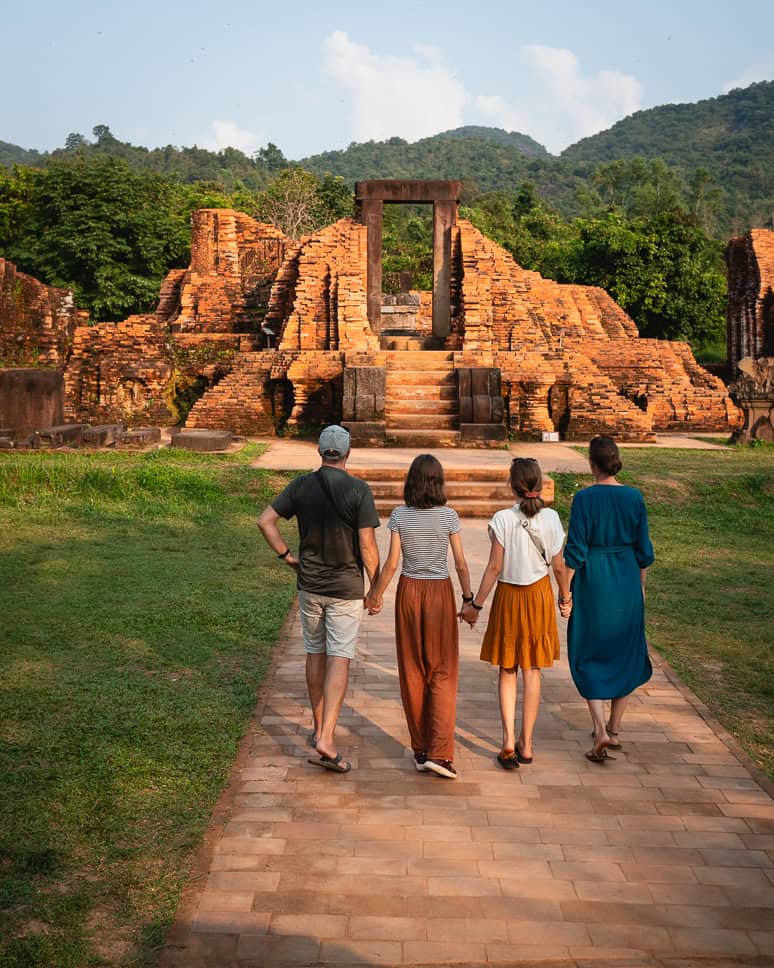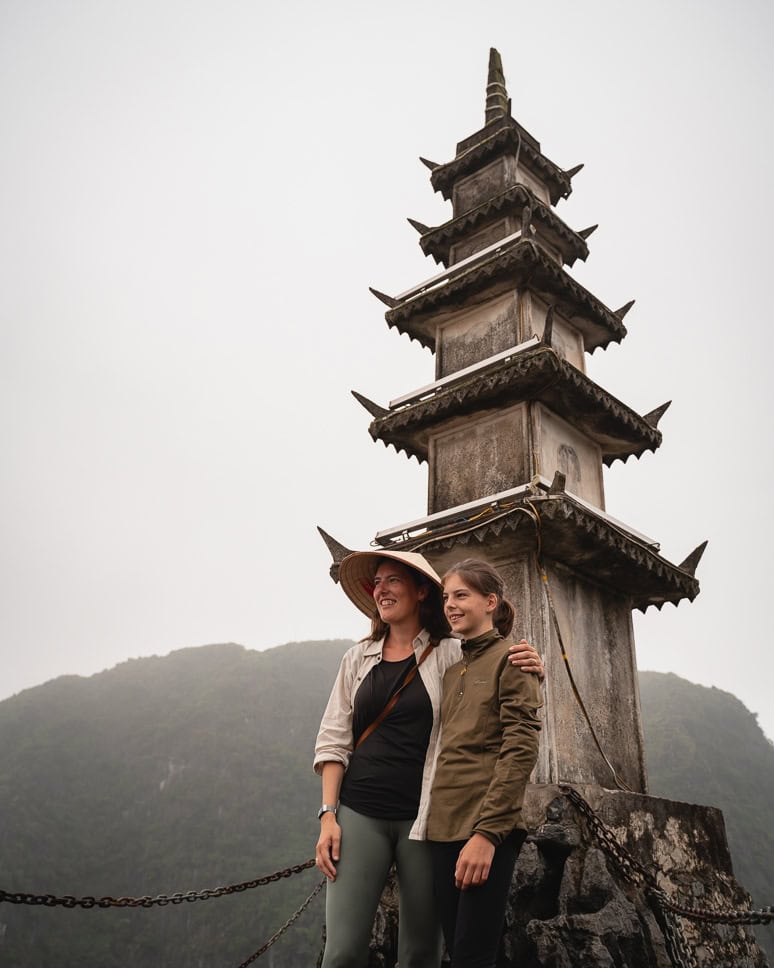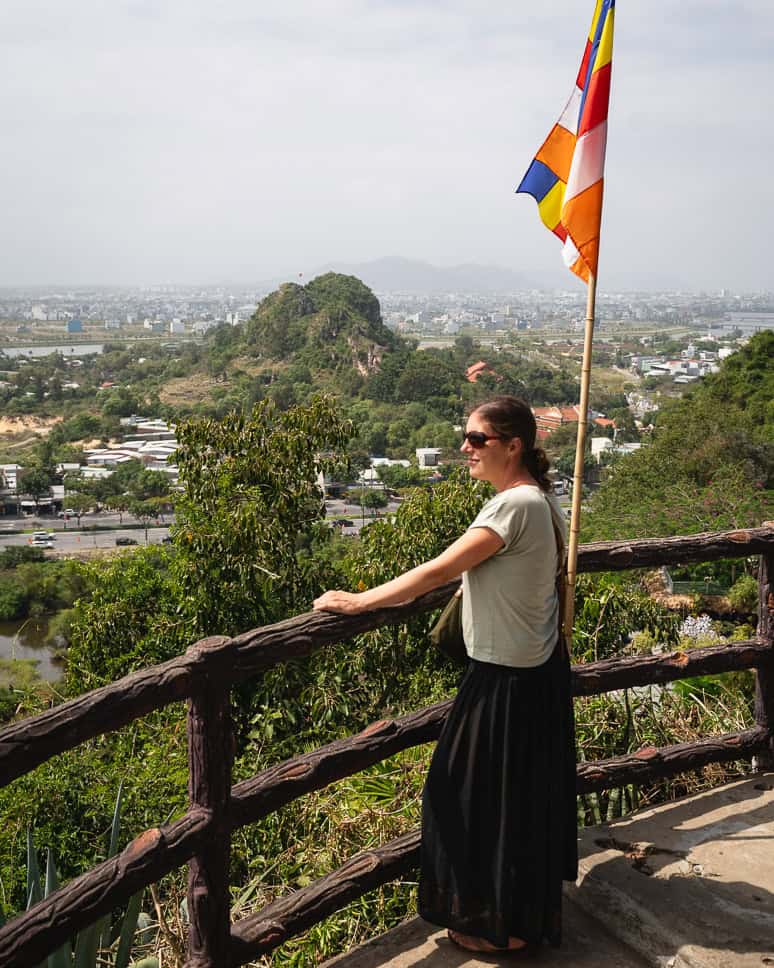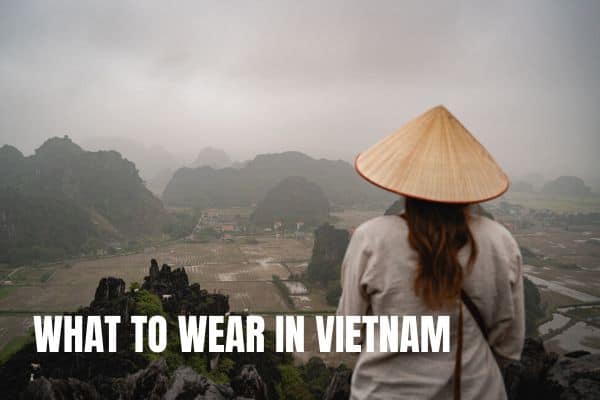The best aesthetic Vietnam travel outfit ideas to pack for your Vietnam trip
Vietnam is a country of stunning natural beauty, rich history, and vibrant culture. From the bustling streets of Ho Chi Minh City in the south to the serene landscapes of Ha Long Bay in the north, each region offers a unique experience. As you prepare for your Vietnam itinerary through the country, understanding what to wear in Vietnam is so important.
Many people expect Vietnam to be warm all year round, but the climate in Vietnam varies significantly from north to south. This diversity means that your clothing choices should be tailored to the specific regions and times of year you plan to visit. Another crucial aspect of dressing in Vietnam is cultural sensitivity. Understanding what is appropriate in certain situations will help you experience the country better.
Before going to Vietnam, I researched the best outfits for Vietnam. In this guide, I will share everything I learned based on our two months in Vietnam. I’ll talk about the essential clothing items to pack for Vietnam’s diverse climate and culture, whether you’re trekking through the mountains, exploring ancient temples, or relaxing on the beach. But also some aesthetic travel outfits for Vietnam (you know, dress to impress) and packing tips, ensuring you are well-prepared for your Vietnam adventure.

Things to know when packing for Vietnam
Understand Vietnam’s climate: consider the region and time of the year you are going
Whether you’re traveling through the northern mountains, exploring the historic sites of central Vietnam, or enjoying the tropical surroundings of the south, understanding the country’s diverse climate is essential! The weather varies significantly from region to region and you need to choose the right clothing for your trip.
Northern Vietnam:
Northern Vietnam experiences four seasons, with cooler temperatures in winter and a hot, humid summer.
- Winter (December to February): temperatures can drop to around 10°C (50°F) in Hanoi, with cool, dry weather. In the mountains, it can be even colder. Layering is key during this season, as mornings and evenings can be chilly.
- Spring (March to May): the weather begins to warm up, with temperatures ranging from 15°C to 25°C (59°F to 77°F). This is a great time to visit, as the landscape comes alive. However, it can still be cold. It was also when we visited Vietnam. We had cold and rainy weather in Halong Bay but nice warm weather in Sapa.
- Summer (June to August): expect hot and humid conditions, with temperatures often exceeding 30°C (86°F). Rain is common, particularly in July and August, so lightweight, breathable clothing and rain gear are essential.
- Autumn (September to November): temperatures begin to cool again, ranging from 20°C to 28°C (68°F to 82°F). This season is characterized by clear skies and comfortable weather, perfect for outdoor activities.


Central Vietnam:
This region has a more moderate climate, with a distinct rainy season from September to December. Temperatures generally range from 20°C to 30°C (68°F to 86°F) throughout the year. Lightweight clothing is suitable, but be prepared for sudden rain showers, especially in the fall.
Southern Vietnam:
The south enjoys a tropical climate with two main seasons: the dry season (November to April) and the rainy season (May to October). During the dry season, temperatures can reach up to 35°C (95°F), while the rainy season brings high humidity and frequent downpours. Light, breathable fabrics are ideal for staying cool and comfortable.
Consider Vietnam’s culture and habits: wear modest clothing
When traveling to Vietnam, understanding and respecting local customs is as important as being aware of the climate. Although Vietnam has many tourists and is used to a lot, the Vietnamese take pride in their traditions, and modest clothing will show respect! Your clothing choices will significantly impact your interactions with locals and your overall experience.
- Temples and religious sites: Vietnam is home to numerous temples, pagodas, and religious sites.
- Both men and women should wear clothing that covers their shoulders and knees. This means opting for long pants or skirts and tops with sleeves. Avoid shorts, tank tops, and revealing clothing, as these are often considered disrespectful. A light scarf or shawl can be used to cover your shoulders if needed.
- Many temples require visitors to remove their shoes before entering. It’s a good idea to wear easily removable footwear, such as sandals or slip-on shoes.
- Modesty in rural areas: while urban areas like Ho Chi Minh City may have a more relaxed dress code, rural communities tend to be more traditional. The south is in general a bit more relaxed than the north. When visiting these areas (for example the hill tribes up north), opt for modest clothing that aligns with local norms to avoid drawing unwanted attention. Opt for pants or skirts that cover your knees and shirts with sleeves to show respect for local customs.

General tips for what to pack for Vietnam
Besides being prepared for all kinds of weather and dressing modestly, here are some more general tips on what to wear in Vietnam.
Since you will be traveling a lot to see the best things to do in Vietnam, you want to pack light! Don’t pack too many sets, as it is very easy to do your laundry in Vietnam, either through your accommodation or by going to a laundry place. Organizing your clothing into packing cubes can help keep your suitcase tidy and make it easier to find items when needed.
Master the art of layering and choose outfits in neutral colors that you can use in different situations, to easily mix and match. Pick breathable and lightweight clothes. Consider quick-drying fabrics, which are especially useful in humid conditions, as they can be washed and dried overnight, keeping your packing light and fresh.
Leave your pair of jeans at home. Not only do they take up a lot of place and weight in your suitcase, but they are also terrible in warm and/or humid weather. Further on in this article about what to wear in Vietnam, we will give you some better alternatives.
Make sure you still have some space left in your luggage. Not only for souvenirs but also for clothes. Especially in Hoi An, you can buy the most beautiful clothes, such as handmade dresses and suits.
Essential outfits in Vietnam per region
As mentioned before, the climate in Vietnam differs a lot depending on where you are. Therefore, understanding the clothing essentials for each region of Vietnam will help you pack wisely and ensure you’re prepared for the varying climates.
What to wear in Northern Vietnam: Hanoi, Sapa, and Halong Bay outfits
Given the cooler temperatures in the winter months, layered clothing is essential. Pack lightweight long-sleeve shirts (such as merino wool thermal shirts), sweaters, and a warm jacket (such as a puffer jacket) for evenings. In spring and autumn, a light jacket or cardigan will suffice. Even consider bringing a beanie and gloves in winter.
If you plan to trek in the mountainous areas of Sapa or explore the bustling streets of Hanoi, comfortable walking shoes are a must. Consider waterproof options, especially if you’re visiting during winter.
In Vietnam, you should always bring rain gear, especially for the northern part. Also, the summer can bring rain, so a lightweight, packable rain jacket or poncho is advisable at any time. In winter you can combine it with your puffer jacket.


What to wear in Central Vietnam: Hue, Phong Nha, and Hoi An outfits
The climate in Central Vietnam can be hot and humid, especially in summer. Choose breathable and lightweight fabrics like linen to stay cool. Short-sleeve shirts, shorts, and summer dresses are ideal for daytime wear, and linen pants for the evening.
Quick-drying clothing is very helpful if you’re visiting during the rainy season. Consider packing quick-drying shirts and pants. to keep you comfortable during sudden downpours.
Pack beachwear if your itinerary includes time on the beaches of Da Nang or Hoi An, such as your swimwear, cover-ups, flip-flops, a beach hat, and sunglasses.


What to wear in Southern Vietnam: Phu Quoc, Mekong Delta, Mui Ne, and Ho Chi Minh outfits
The southern region’s tropical climate calls for light, airy, tropical clothing. Pack short-sleeve shirts, tank tops, and breathable shorts or skirts. Lightweight dresses are also a great option for women, providing comfort in the heat.
With the hot weather, comfortable sandals or flip-flops are ideal for walking around cities and relaxing at the beach. Consider supportive walking shoes if you plan on doing more extensive walking or exploring. Our favorite shoes for tropical environments are these Tropic Feel shoes. You can even use them to swim.
Besides the regular beach wear for a visit to Phu Quoc, the sun can be intense in Southern Vietnam, so it’s essential to protect yourself. Pack a wide-brimmed hat, sunglasses, and a high-SPF sunscreen. Lightweight, long-sleeve shirts can also be beneficial for sun protection during outdoor activities.
If your visit coincides with the rainy season (May to October), bring rain gear to be prepared for sudden rain showers. A compact, waterproof poncho or a light rain jacket can keep you dry without taking up too much space in your luggage.

What to wear in Vietnam as a woman or a man: aesthetic travel outfits for Vietnam
Now that you have a solid understanding of the climate and cultural considerations in Vietnam, it’s time to compile a list of our favorite clothing items that will keep you comfortable, stylish, and respectful throughout your Vietnam travels.
Tops
- Lightweight shirts: opt for loose, breathable but quick-drying fabrics. Cotton is breathable, but doesn’t dry quite as easily in high humidity. Linen T-shirts and shirts are way better for a tropical climate. An alternative is athletic shirts, usually designed to dry quickly and absorb sweat. Choose both 5-7 short-sleeve and 1-2 long-sleeve options to adapt to varying temperatures and settings.
- Button-down shirts: a button-down shirt is perfect for traveling, casual outings, and more formal occasions. We loved our linen button-down shirts for women and men and wore them all the time in Vietnam.
- Layering pieces: if you are planning to visit Northern Vietnam (especially in winter), layering will be key. But also in the rest of the country, a light cardigan, hoodie, or sweater is ideal for cooler evenings or air-conditioned spaces. It might surprise you, but merino wool is perfect for layers, also in warmer weather, since it regulates your body temperature. It is very light, breaths, keeps you warm but doesn’t make you sweat. We would bring a Merino wool thermal shirt and a fleece-lined or Merino pullover everywhere as our extra evening layer.


Bottoms
- Comfortable long pants: lightweight, breathable trousers are essential for visiting temples, for cooler weather, or to protect yourself from mosquitos. Again, linen pants are our favorite. For colder weather, bring trekking leggings or trekking pants.
- Shorts and skirts: pack a couple of pairs of lightweight shorts for hot days, but ensure they are of a modest length, particularly when visiting rural areas or cultural sites. For women, I love my breathable long skirts!
Dresses and overalls
- Casual dresses: lightweight, flowy dresses are perfect for hot weather and can be easily dressed up or down. Look for styles that offer coverage for shoulders and knees.
- Overalls: a great piece to wear in Vietnam, is a lightweight linen overall! It’s stylish and perfect for any weather.


Footwear
- Comfortable walking shoes: as mentioned before, if you are wondering what to pack for Vietnam, you need to bring comfortable but supportive shoes for exploring cities and trekking. We absolutely love our Tropic Feel shoes. They are perfect for walking or trekking, look great as a casual shoe and you can even use them in the water as they dry quickly. The perfect shoe for the tropics. If you visit northern Vietnam in the winter, then you will need waterproof and warmer shoes.
- Sandals or flip flops: for warmer and beach days, bring a pair of sandals or flip flops. We love our Reef flip-flops and the Birkenstock slip-on sandals! You could also choose a good pair of Teva trekking sandals, good for all occasions.
Outerwear
- Lightweight rain jacket or poncho: essential for the rainy season, unexpected showers, or as a waterproof layer in the winter, a lightweight rain jacket is a must-have item to pack for Vietnam.
- Warm jacket: if you plan to visit northern Vietnam in winter, a warm jacket is necessary for cooler temperatures, especially in mountainous areas. We advise you to combine your rain jacket with a puffer jacket. That way, if you continue your travels south, you have layers for all situations.


Swimwear
- Swimsuit: if you plan to visit the beaches in Hoi An, Da Nang, or Phu Quoc, don’t forget your swimsuit. The sun can be fierce in Vietnam, so you want to consider bringing a UV-protection rashguard.
- Cover-up: bring a comfortable cover-up or sarong for beach days to go grab a drink or something to eat at the beach bars and restaurants. Remember Vietnam asks for modest clothing, so don’t walk in your swimwear anywhere else than on the beach.
Accessories
- Wide-brimmed hat: a hat will shield you from the sun and keep you cool during outdoor activities. Choose a wide-brimmed hat for extra protection.
- Sunglasses: protect your eyes from UV rays with a good pair of sunglasses. Look for polarized lenses for added comfort while exploring.
- Lightweight scarf: a versatile accessory that can be used for sun protection, warmth in cooler evenings, or to cover your shoulders when visiting religious sites. Opt for a scarf with a breathable fabric that can easily fit in your bag.
- Daypack: a small, lightweight backpack is useful for day trips and excursions, allowing you to carry essentials like water, snacks, and your camera.
- Fanny pack: a secure fanny pack is ideal for keeping your valuables close while navigating busy markets or city streets.
- Comfortable underwear: pack enough for your trip, considering the humid climate. We love our quick-drying travel underwear.
- Light sleepwear: choose lightweight and breathable sleepwear to ensure comfort during warm nights.

Other essential travel items to pack for Vietnam
Besides the essential travel outfits for Vietnam, we also want to share some other travel items we always travel with.
Must-Have Accessories
- Travel documents organizer: a travel wallet or organizer is essential for keeping your passport, tickets, travel insurance, and other important documents in one place. Look for one with RFID protection to safeguard against identity theft.
- Power bank: with the extensive use of smartphones for navigation, communication, and photography, a portable power bank is invaluable. Choose one with a high capacity to keep your devices charged throughout the day.
- Universal travel adapter: Vietnam uses Type A, C, and D electrical outlets, so a universal travel adapter is necessary to charge your devices. This will ensure you can plug in your electronics without any hassle.
- Water bottle: staying hydrated is crucial, especially in the hot and humid climate of Vietnam. A reusable water bottle, preferably one with insulation, can keep your drinks cool and reduce plastic waste. Look for one that fits in your daypack’s side pocket for easy access.
- Travel pillow and eye mask: for long flights or bus rides, a travel pillow and eye mask can help you get some much-needed rest. Look for inflatable or compressible options that are easy to pack.
- First aid kit: a basic first aid kit with adhesive bandages, antiseptic wipes, pain relievers, and any personal medications is essential for addressing minor health issues while traveling.
Travel Essentials
- Personal hygiene items: we always try to take solid or refillable products to minimize liquid restrictions and reduce waste, such as shampoo bars, conditioner bars, body wash bars, solid deodorant, etc.
- Sunscreen: High SPF sunscreen is vital for protecting your skin from the sun’s rays, especially in tropical climates. Pick reef-friendly sunscreen.
- Insect repellent: insect repellent is also essential to ward off mosquitoes, particularly in rural areas or during the evening. Look for products that contain DEET or natural alternatives like lemon eucalyptus oil for effective protection.
- Travel towel: a quick-drying travel towel is perfect for beach days, hikes, or unexpected rain showers. Choose a compact, lightweight option that can easily fit in your daypack.
- Snacks: having a stash of snacks can be a lifesaver during long journeys or when exploring remote areas. Pack energy bars, nuts, dried fruits, or any other non-perishable snacks that are easy to carry.
- Travel guidebook or app: while digital resources are convenient, having a physical travel guidebook can be helpful, especially in areas with limited internet access. We love the Lonely Planet guides. Alternatively, download offline maps and travel apps (such as maps.me) to assist with navigation and local information.
- Notebook and pen: a small notebook or travel journal can be handy for jotting down thoughts, travel experiences, or important information. It’s also useful for keeping track of expenses or writing down recommendations from locals.
- Camera or smartphone: capture your memories with a good camera or smartphone. If you’re a passionate photographer like me, you’ll love Vietnam. I am a huge fan of my lightweight mirrorless camera.
Read more: What’s in our camera bag: our favorite travel photography gear
Packing list for Vietnam
We want to make sure you don’t forget anything! So to help you out when you’re packing for Vietnam, we’ve created a FREE downloadable and printable Vietnam packing list for you! We also have a storefront on Amazon with all our favourite products.
If you are wondering what to wear in Vietnam, this detailed checklist contains all the necessary items for a successful trip. Besides everything mentioned in this article, you’ll find a few extra things you don’t want to forget.
Happy travels!
Save this for later on Pinterest











